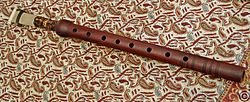 | |
| Woodwind instrument | |
|---|---|
| Classification | Double reed |
| Playing range | |
 | |
| Related instruments | |
| Closely related instruments include the Mey (Turkey), Yasti Balaban (Dagestan), Duduki (Georgia), Duduk (Armenia), Hichiriki (Japan), Piri (Korea), Guanzi (China), and Kamis Sirnay (Kyrgyzstan) | |
| Musicians | |
| Alihan Samedov | |
| Craftsmanship and performing art of balaban/mey | |
|---|---|
| Country | Azerbaijan and Turkey |
| Reference | 01704 |
| Region | Europe and North America |
| Inscription history | |
| Inscription | 2023 (18th session) |
| List | Representative |

Balaban or balaman[7] (Azerbaijani: Balaban – بالابان; Persian: بالابان) is cylindrical-bore, double-reed wind instrument about 35 centimetres (14 in) long with eight finger holes and one thumb hole. This instrument is played in the eastern part of Iran's historic Azerbaijan region as well as in the Republic of Azerbaijan (where it is also called Düdük according to the Encyclopædia Iranica).[6] Balaban, Mey, and Duduk are almost identical, except for historical and geographical differences.[8]
Balaban can be made of mulberry or other harder woods, such as walnut. The bore through the instrument is about 1.5 centimetres (0.59 in) in diameter. The double reed is made out of a single tube of cane about six cm long and pressed flat at one end. The performer uses air stored in his cheeks to keep playing the balaban while he inhales air into his lungs. This “circular” breathing technique is commonly used with all the double-reed instruments in the Middle East.
Balaban can be found in regions of the Republic of Azerbaijan, Iran and Turkey. It is sometimes used as Balaman, Mey or Whistle, among Azerbaijan and Turkistan in the West Azerbaijan region.
Consisting of a body (govda) and a mouth-worn flat reed mouthpiece, Balaban is 280-300 millimeters long and 20-22 millimeters in diameter. The sound is dull and light, and because it is weak, it is mostly played in closed spaces and room meetings. Thanks to the clamp on the reed, the sound can be thinned and thickened. The cane, flattened by a special method, consists of a clamp and a body. By pushing the grapple upwards or downwards on the reed, one-curtain sound change can be made and it can adapt to the instrument groups immediately. Another type of Balaban is used in ashiq music. Alihan Samedov is a famous Azerbaijani balaban artist.
- ^ "Толковый словарь русского языка Кузнецова. 1 е изд е: СПб.: Норинт. С. А. Кузнецов". Archived from the original on 2012-07-09. Retrieved 2012-07-18.
- ^ "БАЛАМАН в музыкальной энциклопедии". Music-dic.ru. Retrieved 21 April 2021.
- ^ "Atlas of traditional music of Azerbaijan". Atlas.musigi-dunya.az. Retrieved 21 April 2021.
- ^ "Статьи, обзоры и лонгриды о главном на iz.ru | Известия". Iz.ru. Retrieved 21 April 2021.
- ^ Сергей Александрович Токарев. Основы этнографии: Учеб. пособие для ист. специальностей вузов.. — Высшая школа, 1968. — С. 311. — 359 с.
- ^ a b Encyclopaedia Iranica. Balaban. Archived 2011-08-05 at the Wayback Machine: «BĀLĀBĀN, a cylindrical-bore, double-reed wind instrument about 35cm long with seven finger holes and one thumb hole. It is played in eastern Azerbaijan in Iran and Soviet Azerbaijan (where it is also called düdük).»
- ^ Музыкальная энциклопедия. Баламан. Под ред. Ю. В. Келдыш. Т 1. А — М.: Советская энциклопедия, 1973.
- ^ A COMPARATIVE VIEW OF THE MEY, BALABAN AND DUDUK AS ORGANOLOGICAL PHENOMENARetrieved February 28, 2022.